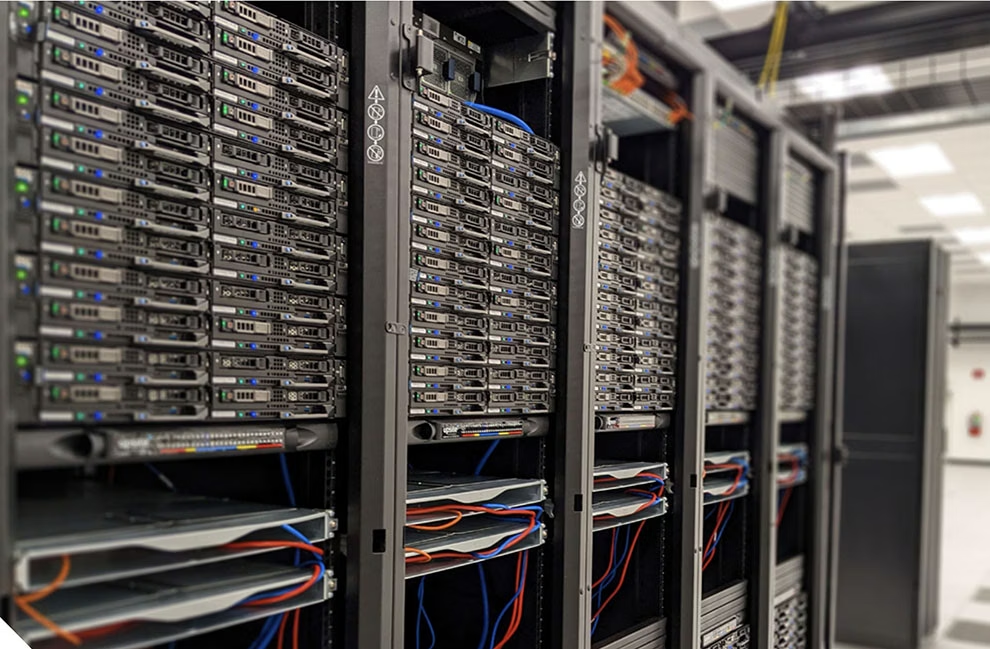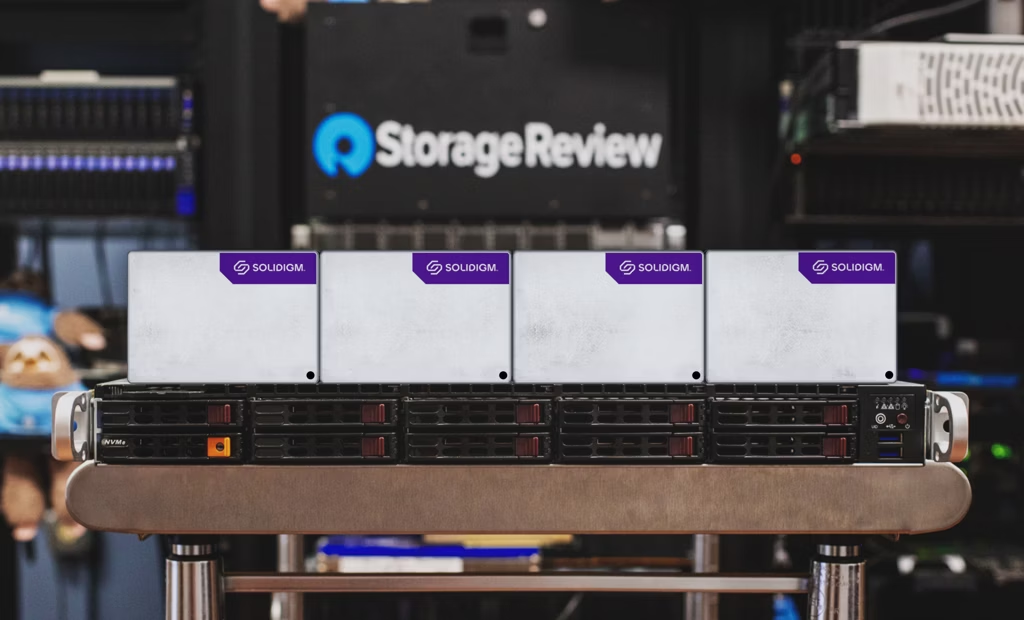Replace Legacy Storage in Content Delivery Networks
Cost-effective, high-capacity Solidigm™ D5 Series SSDs; the right solution for CDNs
Solidigm D5 Series QLC 3D NAND SSDs, built on a proven floating gate technology, include a PCIe 4.0 controller and modern firmware to enable large-capacity drives with exceptional read performance for warm data. As a result, these drives can replace hybrid configurations consisting of triple-level cell (TLC) NAND solid state drive (SSD) and hard disk drive (HDD) configurations in certain deployments to realize significant benefits in server density and total cost of ownership (TCO) savings.

As video on demand (VoD) grows in popularity, data storage needs to keep up
More and more consumers are turning to streaming media for entertainment. Netflix recorded more than 200 million subscribers worldwide in 2020, an increase of 37 million from 2019.1 Hulu reported 35.4 million VoD subscribers in Q1 2021, up 30% year-over-year.2 Overall, the streaming market has grown into a multi-billion-dollar industry over the last decade.
VoD content providers have had to respond to the increase in subscribers by spending more to expand their content libraries. In addition, the industry is quickly moving to provide consumers with richer content, which—combined with more users—results in a massive uptick in data to store and deliver.
For example, if a given 720p video consumes 2 to 3 GB of storage, a 1080p version of the same video consumes about 4 to 5 GB, thereby nearly doubling the amount of streaming data. That massive and expanding data needs to be stored efficiently in order to limit costs for content providers and to meet customer service levels.
Moving content closer to the edge
Mid-tier and edge servers are used to move content closer to end users in order to optimize customer experiences and reduce overall CDN cost. See Figure 1. These servers drive a read-intensive, large-block storage workload with a focus on system-level latency to improve the user experience (UX). Mid-tier and edge servers also need to meet locality constraints in terms of space, power, and cooling.
To meet these requirements, storage architects need to take into account the unique characteristics inherent to VoD content. Workloads are very read-intensive (up to 95%). Writes, which generally only happen during low-write use periods when new content is uploaded, are highly sequential. Both reads and writes typically consist of large block sizes of up to 128K.
Both mid-tier and edge scenarios share similar challenges, including the need to:
- Optimize space and operational efficiency
- Solve for throughput efficiency
- Scale to more content, richer content, and more users within locality constraints

Figure 1. VoD content providers stage content on mid-tier and edge servers to improve the UX
Deploying the right storage for VoD workloads
Given those characteristics, what would be the ideal storage to solve CDN providers’ most pressing needs while providing scalability for growth? While storage configurations can vary, most commonly, hybrid arrays of TLC NAND SSDs and HDDs are found in both the mid-tier and edge. But both HDDs and TLC NAND SSDs have significant drawbacks for CDN providers looking to meet service requirements in the most cost-effective way.
HDDs are space-inefficient and have a high operating cost. Additionally, their poor performance means they must be paired with TLC NAND SSDs to achieve required throughput. TLC NAND SSDs have ample performance but are not cost-optimized. Therefore, they are frequently not the best choice for CDN providers looking to optimize cost per throughput.
Reliable, cost-effective performance for CDN workloads
Solidigm D5 Series SSDs based on quad-level (QLC) technology are an ideal fit for VoD workloads in both mid-tier and edge locations because QLC NAND drives offer read performance that is on par with TLC NAND SSDs, and that is significantly higher than HDDs.
In addition, Solidigm D5 Series SSDs allow for massive density that accommodates scalability for future needs, while helping lower TCO today. Table 1 highlights the benefits of deploying an all-QLC NAND array over a hybrid array.

Table 1. Benefits of using a Solidigm D5-P5316 drive over a common HDD for key CDN metric3
Replace TLC NAND SSDs + HDDs with D5 Series QLC NAND SSDs in mid-tier servers
Mid-tier servers have read-intensive workloads—typically up to 95% reads with sequential writes only occurring at low-use periods. That makes QLC NAND SSDs a strong candidate to replace the hybrid arrays (TLC NAND SSD + HDD) commonly found in these servers.
This is partly due to QLC NAND SSDs having TLC NAND SSD–equivalent read performance. But QLC NAND SSDs also have more than sufficient endurance for the job, when taking into account the large capacity of these drives compared to the limited write pressure of the workload. For example, a 30.72 TB QLC NAND SSD x 0.41 drive writes per day (DWPD) x 365 days per year x 5 years equals 23 petabytes written (PBW).
Modeling a mid-tier installation requiring 480 TB-per-node capacity and 190 Gbps-per-node throughput results in a nearly 5x increase of server density, with a TCO reduction of up to 14 percent, as shown in Figure 2.4 In the original hybrid array, HDD storage needs to be significantly overprovisioned beyond capacity needs in order to meet throughput requirements.
Replacing the overprovisioned array in this theoretical example with all QLC NAND SSDs reduces the number of servers from 331 to 67, leaving ample room for growth to scale with changing needs in content and users. Driving these impressive gains is the read-optimized performance of QLC NAND SSDs, which enables organizations to eliminate using TLC NAND SSDs as cache drives and replace HDDs with more space- and operationally-efficient capacity storage.

Figure 2. Solidigm SSDs replace hybrid storage arrays in mid-tier servers for server density
Replace hybrid array or all-TLC NAND with D5 Series QLC NAND SSDs in edge servers
Edge servers have a similar workload profile to mid-tier servers, so they can also benefit from the read performance and capacity optimization of QLC NAND SSDs. One way to quantify these benefits is to model a server requiring 128TB capacity and 300 Gbps throughput under two different scenarios.
Scenario 1 is ideal in emerging markets, where updating legacy hybrid array CDNs (TLC NAND SSD + HDD) to an all-QLC NAND SSD solution delivers up to 3.7x increase in server density and up to 2.3x TCO savings, with massively reduced operating expense (OpEx) benefits via footprint reduction, power and cooling efficiencies, and fewer drive replacements over time.5
Scenario 2 targets a more typical all-TLC NAND SSD implementation, where choosing all-QLC NAND results in 22 percent greater server density and up to 20 percent TCO savings, allowing providers to scale more efficiently while maintaining read-intensive content-delivery service-level agreements (SLAs).6

Figure 3. Solidigm SSDs replace TLC or hybrid storage arrays in mid-tier servers for server density
Additional Solidigm D5 Series SSD benefits
In addition to the server TCO benefits noted above, QLC NAND SSD arrays at mid-tier and edge servers can benefit CDN providers in other areas as well:
- Reduce downstream network traffic (return-to-source rate) through higher server bandwidth
- Economically scale to more content and more users with higher per-node capacity and bandwidth
- Improve first packet response times through low latency and high quality of service (QoS)
Modernize storage to keep up with demand
VoD services are seeing explosive growth, putting pressure on service providers to meet that growth opportunity while maintaining service levels and improving efficiency to control costs.
Solidigm D5 Series 3D NAND SSDs offer an alternative to HDDs and TLC NAND SSDs for affordably modernizing storage to better support on-demand content delivery. With read performance equivalent to TLC NAND SSDs and much higher than HDDs, Solidigm D5 Series SSDs help storage architects reduce TCO, efficiently scale content, and expand content to more users.
About the Author
Ace Stryker is Director of Market Development at Solidigm, where he focuses on emerging applications for the company’s portfolio of data center storage solutions.
[1] Netflix. Shareholder letter. January 2021. https://s22.q4cdn.com/959853165/files/doc_financials/2020/q4/FINAL-Q420-Shareholder-Letter.pdf.
[2] Fierce Video. “Hulu + Live TV loses 100,000 subscribers in Q4.” February 2021. fiercevideo.com/video/hulu-live-tv-loses-100-000-subscribers-q4.
[3] Based on specifications for Solidigm SSD D5-P5316: solidigm.com/en/products/data-center/ssd-d5-series/ ssd-d5-p5316-series-30-72tb-2-5in-pcie-4-0-x4-3d4-qlc.html, and Seagate Exos X18: seagate.com/files/www-content/datasheets/pdfs/ exos-x18-channel-DS2045-1-2007GB-en_SG.pdf.
[4] Source for consolidating servers by nearly 5x and reducing TCO by up to 42 percent when upgrading from a hybrid TLC SSD and HDD array to an all-QLC SSD array:
Baseline server assumptions of 20K actives users, minimum capacity of 480 TB, target throughput of 190 Gbps, and 85 percent cache hit ratio. Hybrid array per server configuration of 2 x Intel® Xeon® Scalable 6330 processors, 512 GB memory, 12 x 8 TB Seagate Exos HDD with 2.088 Gbps throughput, 2 x 7.68 TB Solidigm D7-P5510 with 56 Gbps throughput. Hybrid array cost (CPU + memory + RAID controller + NVMe expander + chassis + power supply) net of storage: $10,530. All-QLC per server configuration of 2 x Intel Xeon Scalable 6338N processors, 512 GB memory, 20 x 30.72 TB Solidigm D5-P5316 with 54.4 Gbps throughput. All-QLC server cost (CPU + memory + RAID controller
+ NVMe expander + chassis + power supply) net of storage: $11,530. HDD pricing from serversupply.com/HARD%20DRIVES/SATA-6GBPS/8TB-7200RPM/SEAGATE/ ST8000NM000A_326073.htm, as of September 24, 2021. SSD pricing is Solidigm Recommended Customer Price (RCP) as of September 24, 2021. Actual price can vary and may not reflect the pricing used in the TCO model. Operating cost assumptions of 1,100 watts/server $0.12/kWh power and cooling and $75.76 annual rack cost per RU.
[5] Source for 3.7x server consolidation and up to 2.3x TCO savings when upgrading from a hybrid TLC SSD and HDD array to an all-QLC SSD array:
Baseline server assumptions of 20K active users, minimum capacity of 128 TB, target throughput of 300 Gbps, and 85 percent cache hit ratio. Hybrid array per server configuration of 2 x Intel Xeon Scalable 6330 processors, 512 GB memory, 12 x 8 TB Seagate Exos HDD with 2.088 Gbps, 2 x 7.68 TB Solidigm D7-P5510 with 56 Gbps throughput. Hybrid array cost (CPU + memory + RAID controller + NVMe expander + chassis + power supply) net of storage: $11,930. All-QLC per server configuration of 2 x Intel Xeon Scalable 6338N processors, 512 GB memory, 16 x 30.72 TB Solidigm D5-P5316 with 54.4 Gbps throughput. All-QLC server cost (CPU + memory + RAID controller
+ NVMe expander + chassis + power supply) net of storage: $12,930. HDD pricing from www.serversupply.com/HARD%20DRIVES/SATA-6GBPS/8TB-7200RPM/SEAGATE/ ST8000NM000A_326073.htm, as of September 24, 2021. SSD pricing is Solidigm Recommended Customer Price (RCP) as of September 24, 2021. Actual price can vary and may not reflect the pricing used in the TCO model. Operating cost assumptions of 1,100 watts/server, $0.12/kWh power and cooling, and $75.76 annual rack cost per RU.
[6] Source for 22 percent server consolidation and up to 20 percent TCO savings when comparing an all-TLC SSD array to an all-QLC SSD array:
Baseline server assumptions of 20K active users, minimum capacity of 128 TB, target throughput of 300 Gbps, and 85 percent cache hit ratio. Hybrid array per server configuration of 2 x Intel Xeon Scalable 6330 processors, 512 GB memory, 20 x 7.68 TB Solidigm D7-P5510 with 56 Gbps throughput. Hybrid array cost (CPU + memory + RAID controller + NVMe expander + chassis + power supply) net of storage: $12,930. All-QLC per server configuration of 2 x Intel Xeon Scalable 6338N processors, 512 GB memory, 16 x 30.72 TB Solidigm D5-P5316 with 54.4 Gbps throughput. All- QLC server cost (CPU + memory + RAID controller + NVMe expander + chassis + power supply) net of storage:
$12,930. SSD pricing is Solidigm Recommended Customer Price (RCP) as of September 24, 2021. Actual price can vary and may not reflect the pricing used in the TCO model. Operating cost assumptions of 1,100 watts/server, $0.12/kWh power and cooling, and $75.76 annual rack cost per RU.
Tests document performance of components on a particular test, in specific systems. Differences in hardware, software, or configuration will affect actual performance. Consult other sources of information to evaluate performance as you consider your purchase.
Cost reduction scenarios described are intended as examples of how a given Solidigm-based product, in the specified circumstances and configurations, may affect future costs and provide cost savings. Circumstances will vary. Solidigm does not guarantee any costs or cost reduction. Solidigm does not control or audit the design or implementation of third-party benchmark data or Web sites referenced in this document. Solidigm encourages all of its customers to visit the referenced Web sites or others where similar performance benchmark data are reported and confirm whether the referenced benchmark data are accurate and reflect performance of systems available for purchase.
Solidigm technologies may require enabled hardware, software or service activation. No product or component can be absolutely secure. Your costs and results may vary. Performance varies by use, configuration and other factors. Solidigm is committed to respecting human rights and avoiding complicity in human rights abuses. Solidigm products and software are intended only to be used in applications that do not cause or contribute to a violation of an internationally recognized human right. Solidigm does not control or audit third-party data. You should consult other sources to evaluate accuracy.
“Solidigm” is a trademark of SK hynix NAND Product Solutions Corp (d/b/a Solidigm). Other names and brands may be claimed as the property of others.


